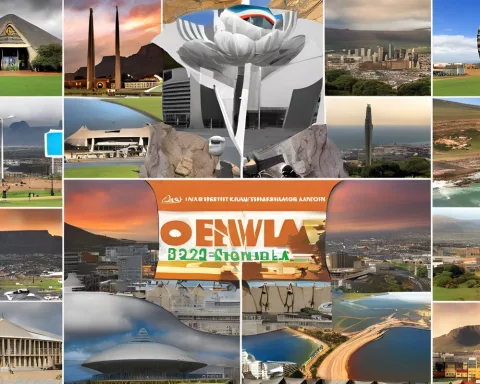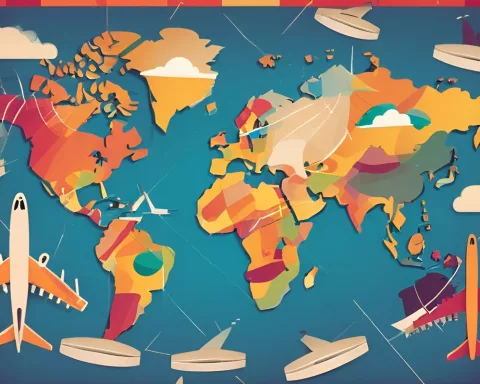FlySafair is changing air travel by showcasing local South African artists’ skills on their planes, creating a unique and uplifting atmosphere. The airline’s dedication to promoting local talent and integrating it into their business strategy provides a model for other companies to follow. This innovative approach transforms the passenger experience, connecting the airline, its passengers, and the artists, while contributing to the community and redefining in-flight experiences. FlySafair’s campaign harnesses the power of art to create an inspiring and hopeful future for the airline industry.
FlySafair is revolutionizing air travel by championing local art. The airline has transformed several planes into vibrant airborne galleries, spotlighting the skills of select South African artists and creating an uplifting inflight ambiance that is distinctly South African. FlySafair’s innovative approach provides a model for other companies to emulate, integrating support for local talent into their business strategies.
Embracing Art in Air Travel
FlySafair, widely recognized as South Africa’s treasured budget airline, reaffirms its support for local creatives once again. It has taken a page from Lift Airline’s successful artist campaigns, transforming the interiors of several planes into vibrant airborne galleries, spotlighting the skills of select South African artists. This marks the second incarnation of FlySafair’s art campaign, originally launched in 2022 as a sincere tribute to local artisans.
COO of FlySafair, Kirby Gordon, expresses his enthusiasm about the comeback of the campaign. He believes in the power of art as a communication medium, transcending language and cultural barriers, as stated in Tourism Update. Gordon’s passion for art is mirrored in FlySafair’s love for aviation, which it engages to help passengers rekindle their own affinity for air travel, especially following the pandemic’s challenges. Moreover, the carrier maintains its dedication to promoting local talents.
Gordon elaborates on the motive behind the project, recalling the heightened stress around air travel due to the close quarters it necessitated. “While that period is behind us now, what better way could there be to renew our shared appreciation for flight and South Africa than through the medium of art,” he mentioned.
A South African Inflight Experience
Passengers aboard FlySafair are in for an artistic treat. The carrier has personally chosen designs by six local artists, converted them into flight-friendly materials, and integrated them into the interiors of select aircraft. These vibrant displays, alongside art by children supported by Wings and Wishes, create an uplifting inflight ambiance distinctly South African.
FlySafair’s progress is nothing short of remarkable. From 2020 onwards, the airline has capitalized on opportunities for expansion. It has added scheduled services on numerous fresh routes, offering passengers exciting destinations in neighboring countries such as Maputo, Livingstone, Harare, and Victoria Falls.
The airline has also built a reputation for punctuality. In a recent evaluation, FlySafair clinched the title of the world’s most on-time budget carrier, a distinction that undoubtedly separates it from its rivals.
Reinventing The Airline Industry
The airline’s strategy of celebrating local art and fostering a passion for flying is a splendid showcase of its creative foresight and solid dedication to nurturing local talent. It provides passengers with a one-of-a-kind flying experience. This harmonious marriage of business and community engagement sets a new benchmark for other airlines to strive for.
FlySafair’s pioneering campaign provides a model for other companies to emulate, integrating support for local talent into their business strategies. Breathing creativity into the cabin elevates the passenger experience to an unprecedented level. The shared appreciation of art serves as a link connecting the airline, its passengers, and the artists.
This innovative approach signals a hopeful future for the airline industry. It hints at a world where enterprises like FlySafair continue to redefine inflight experiences while fostering local talent and contributing to the community. The power of art to cross language and cultural barriers, as emphasized by Gordon, is indeed a universal truth. It is downright inspiring to witness it being embraced in such a distinct manner.
Beyond the Skies: Harnessing the Power of Art
FlySafair’s art campaign disrupts stereotypes of the airline industry as one indifferent to creativity. It serves as a beacon, demonstrating how successful business models can merge with a passion for art, culture, and community. In essence, FlySafair has proven that the sky is merely the starting line when it comes to leveraging the potency of art to enhance customer experiences.
What is FlySafair’s approach to air travel?
FlySafair is changing air travel by showcasing local South African artists’ skills on their planes, creating a unique and uplifting atmosphere. The airline’s dedication to promoting local talent and integrating it into their business strategy provides a model for other companies to follow.
How has FlySafair transformed the passenger experience?
FlySafair has transformed several planes into vibrant airborne galleries, spotlighting the skills of select South African artists and creating an uplifting inflight ambiance that is distinctly South African. Passengers aboard FlySafair are in for an artistic treat with the carrier personally choosing designs by six local artists, converted them into flight-friendly materials, and integrated them into the interiors of select aircraft.
What sets FlySafair apart from its rivals?
FlySafair has built a reputation for punctuality. In a recent evaluation, FlySafair clinched the title of the world’s most on-time budget carrier, a distinction that undoubtedly separates it from its rivals.
What is the motive behind FlySafair’s art campaign?
The motive behind FlySafair’s art campaign is to renew the shared appreciation for flight and South Africa through the medium of art. The carrier maintains its dedication to promoting local talents and celebrating local art in a creative way that sets a new benchmark for other airlines to strive for.
How does FlySafair harness the power of art?
FlySafair’s art campaign disrupts stereotypes of the airline industry as one indifferent to creativity. It serves as a beacon, demonstrating how successful business models can merge with a passion for art, culture, and community. The airline has proven that the sky is merely the starting line when it comes to leveraging the potency of art to enhance customer experiences.
What does FlySafair’s innovative approach signal for the airline industry?
FlySafair’s innovative approach signals a hopeful future for the airline industry. It hints at a world where enterprises continue to redefine inflight experiences while fostering local talent and contributing to the community. The power of art to cross language and cultural barriers is indeed a universal truth.












